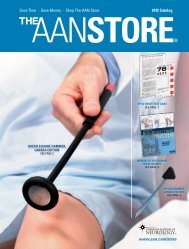Practice parameter: Evaluating a first nonfebrile seizure in children
Practice parameter: Evaluating a first nonfebrile seizure in children
Practice parameter: Evaluating a first nonfebrile seizure in children
Create successful ePaper yourself
Turn your PDF publications into a flip-book with our unique Google optimized e-Paper software.
on long-term treatment and management. 20,22 Factors<br />
to be considered <strong>in</strong>clude the age of the child, the<br />
need for sedation to perform the study, the EEG<br />
results, a history of head trauma, and other cl<strong>in</strong>ical<br />
circumstances such as a family history of epilepsy.<br />
Recommendations.<br />
• If a neuroimag<strong>in</strong>g study is obta<strong>in</strong>ed, MRI is the<br />
preferred modality. 50,51,54,60,62,63,65 (Guidel<strong>in</strong>e)<br />
Emergent neuroimag<strong>in</strong>g should be performed <strong>in</strong> a<br />
child of any age who exhibits a postictal focal deficit<br />
(Todd’s paresis) not quickly resolv<strong>in</strong>g, or who has not<br />
returned to basel<strong>in</strong>e with<strong>in</strong> several hours after the<br />
<strong>seizure</strong>. 46,66 (Option)<br />
• Nonurgent imag<strong>in</strong>g studies with MRI should be<br />
seriously considered <strong>in</strong> any child with a significant<br />
cognitive or motor impairment of unknown etiology,<br />
unexpla<strong>in</strong>ed abnormalities on neurologic exam<strong>in</strong>ation,<br />
a <strong>seizure</strong> of partial (focal) onset with or<br />
without secondary generalization, an EEG that<br />
does not represent a benign partial epilepsy of<br />
childhood or primary generalized epilepsy, or <strong>in</strong><br />
<strong>children</strong> under 1 year of age. 20,34 (Option)<br />
Summary. In the child with a <strong>first</strong> <strong>nonfebrile</strong> <strong>seizure</strong>,<br />
diagnostic evaluations <strong>in</strong>fluence therapeutic<br />
decisions, how families are counseled, and the need<br />
for hospital admission and/or specific follow-up<br />
plans. This practice <strong>parameter</strong> has reviewed the<br />
published literature concern<strong>in</strong>g the usefulness of<br />
studies follow<strong>in</strong>g a <strong>first</strong> <strong>nonfebrile</strong> <strong>seizure</strong> <strong>in</strong> <strong>children</strong>,<br />
and has classified the strength of the available<br />
evidence. There is sufficient Class I evidence, which<br />
<strong>in</strong>volves a well executed prospective study, to provide<br />
a recommendation with the highest degree of<br />
cl<strong>in</strong>ical certa<strong>in</strong>ty—i.e., a Standard—that an EEG be<br />
obta<strong>in</strong>ed <strong>in</strong> all <strong>children</strong> <strong>in</strong> whom a <strong>nonfebrile</strong> <strong>seizure</strong><br />
has been diagnosed, to predict the risk of recurrence<br />
and to classify the <strong>seizure</strong> type and epilepsy syndrome.<br />
The decision to perform other studies, <strong>in</strong>clud<strong>in</strong>g<br />
LP, laboratory tests, and neuroimag<strong>in</strong>g, for the<br />
purpose of determ<strong>in</strong><strong>in</strong>g the cause of the <strong>seizure</strong> and<br />
detect<strong>in</strong>g potentially treatable abnormalities, will<br />
depend on the age of the patient and the specific<br />
cl<strong>in</strong>ical circumstances. Children of different ages<br />
may require different management strategies. 20,22<br />
Future research. For most of the questions addressed<br />
by this <strong>parameter</strong>, evidence was <strong>in</strong>sufficient<br />
for mak<strong>in</strong>g a strong recommendation for a standard<br />
or guidel<strong>in</strong>e, particularly for laboratory studies. In<br />
order to generate def<strong>in</strong>itive evidence regard<strong>in</strong>g the<br />
value of rout<strong>in</strong>e (or selective) laboratory test<strong>in</strong>g and<br />
the use of rout<strong>in</strong>e neuroimag<strong>in</strong>g studies, sufficiently<br />
large samples allow<strong>in</strong>g for adequate statistical power<br />
to provide precise estimates (i.e., with narrow confidence<br />
<strong>in</strong>tervals) are needed. Neuroimag<strong>in</strong>g studies<br />
are needed to understand the significance of neuronal<br />
migration defects <strong>in</strong> the context of a <strong>first</strong> <strong>seizure</strong>,<br />
and are important because of the improved technical<br />
ability of current MRI. In addition, prospective collection<br />
of data us<strong>in</strong>g standardized treatment protocols<br />
and standardized data collection <strong>in</strong>struments is<br />
essential. Results of studies will only be helpful if<br />
the patient sample and factors that resulted <strong>in</strong> <strong>in</strong>clusion<br />
<strong>in</strong>to or exclusion from the sample are well described<br />
and documented. Ideally, large consecutive<br />
series of well-characterized patients are needed for<br />
the results to be accurate and generalizable. F<strong>in</strong>ally,<br />
future studies should present separate data from<br />
<strong>children</strong> and adults, and it would be optimal for results<br />
<strong>in</strong> <strong>children</strong> to be presented by age group<strong>in</strong>gs.<br />
Appropriate tim<strong>in</strong>g as well as the choice of evaluative<br />
studies have not been adequately studied. Children<br />
may present as actively hav<strong>in</strong>g a <strong>seizure</strong> when<br />
brought to the emergency department, as postictal,<br />
or as alert with a history of a possible <strong>seizure</strong> episode<br />
hav<strong>in</strong>g occurred hours, days, or weeks previously.<br />
Data regard<strong>in</strong>g the appropriate tim<strong>in</strong>g of<br />
laboratory test<strong>in</strong>g, neuroimag<strong>in</strong>g, or EEG studies require<br />
adequate prospective studies of these specific<br />
questions, with clearly def<strong>in</strong>ed entry criteria and a<br />
common protocol for type and tim<strong>in</strong>g of evaluations.<br />
Research studies with adequate sample sizes and<br />
appropriate protocols that provide answers to these<br />
questions may serve to reduce the expense and discomfort<br />
of unnecessary test<strong>in</strong>g <strong>in</strong> <strong>children</strong> with <strong>first</strong><br />
<strong>seizure</strong>s, and, more importantly, by identify<strong>in</strong>g appropriate<br />
candidates, may improve the care and<br />
management that these <strong>children</strong> receive.<br />
Disclaimer. This statement is provided as an educational<br />
service of the American Academy of Neurology.<br />
It is based on an assessment of current scientific<br />
and cl<strong>in</strong>ical <strong>in</strong>formation. It is not <strong>in</strong>tended to <strong>in</strong>clude<br />
all possible proper methods of care for a particular<br />
neurologic problem or all legitimate criteria for<br />
choos<strong>in</strong>g to use a specific procedure. Neither is it<br />
<strong>in</strong>tended to exclude any reasonable alternative<br />
methodologies. The AAN recognizes that specific patient<br />
care decisions are the prerogative of the patient<br />
and the physician car<strong>in</strong>g for the patient, based on all<br />
of the circumstances <strong>in</strong>volved.<br />
Acknowledgment<br />
The authors thank the members of the Quality Standards Subcommittee<br />
of the AAN, and Wendy Edlund, the AAN Cl<strong>in</strong>ical<br />
Policy Adm<strong>in</strong>istrator, for their time, expertise, and efforts <strong>in</strong> develop<strong>in</strong>g<br />
this document.<br />
Appendix 1<br />
Classification of evidence<br />
Class I. Must have all of a–d:<br />
a. Prospective study of a well def<strong>in</strong>ed cohort which <strong>in</strong>cludes a<br />
description of the nature of the population, the <strong>in</strong>clusion/exclusion<br />
criteria, demographic characteristics such as age and sex, and<br />
<strong>seizure</strong> type.<br />
b. The sample size must be adequate with enough statistical<br />
power to justify a conclusion or for identification of subgroups for<br />
whom test<strong>in</strong>g does or does not yield significant <strong>in</strong>formation.<br />
c. The <strong>in</strong>terpretation of evaluations performed must be done<br />
bl<strong>in</strong>ded to outcome.<br />
d. There must be a satisfactory description of the technology<br />
used for evaluations (e.g., EEG, MRI).<br />
September (1 of 2) 2000 NEUROLOGY 55 621



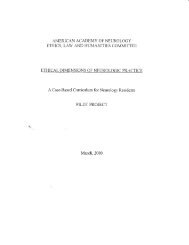

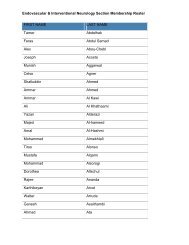
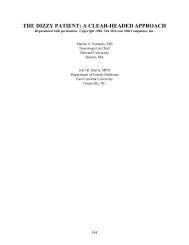

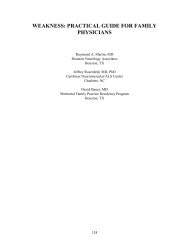
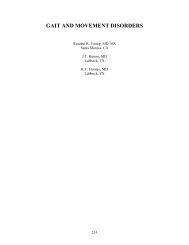
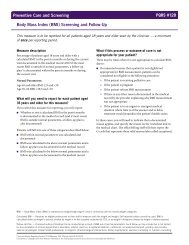
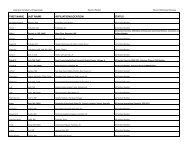
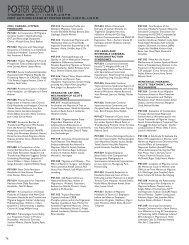
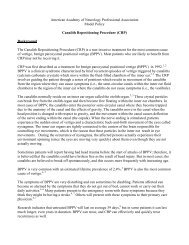
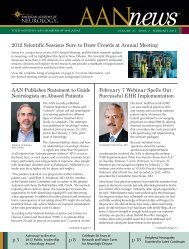
![[Click here and type date] - American Academy of Neurology](https://img.yumpu.com/8582972/1/190x245/click-here-and-type-date-american-academy-of-neurology.jpg?quality=85)
